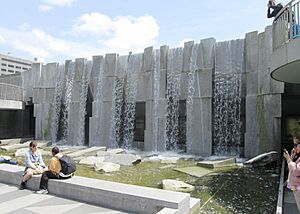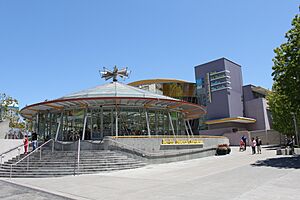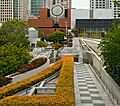Yerba Buena Gardens facts for kids
Quick facts for kids Yerba Buena Gardens |
|
|---|---|
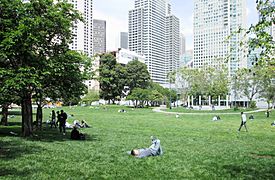
(2017)
|
|
| Lua error in Module:Location_map at line 420: attempt to index field 'wikibase' (a nil value). | |
| Type | Urban |
| Location | South of Market, San Francisco, California |
| Nearest city | San Francisco |
| Created | 1993 |
| Operated by | San Francisco Redevelopment Agency |
| Open | All year |
| Status | Open |
Yerba Buena Gardens is a cool public park area in downtown San Francisco, California. It's located between Third and Fourth Streets, and Mission and Folsom Streets. The park is actually made up of two main sections.
The first part of the park opened on October 11, 1993. The second part opened in 1998. This second section was specially dedicated to Martin Luther King Jr. by Mayor Willie Brown. A special bridge for people to walk on connects the two parts of the park. This bridge goes over Howard Street and sits on top of a convention center called the Moscone Center.
The San Francisco Redevelopment Agency owns Yerba Buena Gardens. It was planned and built as a main part of a bigger city improvement project. This project also includes the Yerba Buena Center for the Arts.
The name "Yerba Buena" comes from the original name of the town that later became San Francisco. This was when the area was part of Mexico. The town was named after a plant called yerba buena (which means "good herb" in Spanish). This plant used to grow a lot in the area.
Contents
History of Yerba Buena Gardens
The idea for a big conference center and park in downtown San Francisco started way back in the late 1950s. City leaders wanted to make the city center better, especially old industrial areas that weren't being used much anymore. The main goal was to help San Francisco become a city known for tourism and conventions, instead of just factories.
The specific idea for the Yerba Buena Center came up in the early 1960s. At that time, people were thinking about how to develop the downtown area. The South of Market area had lots of flat land that wasn't too expensive.
Things really started moving when George Moscone became mayor in 1976. He pushed for the construction of the center. Later, the Gardens were built as part of a deal Mayor Moscone made with developers. This deal made sure that land and money were set aside for important cultural places like museums and theaters.
Awards and Community Impact
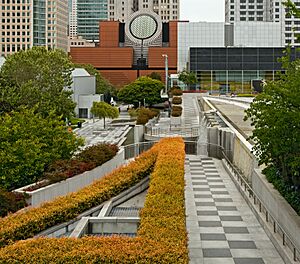
In 1999, Yerba Buena Gardens won a special award called the Gold Medal of the Rudy Bruner Award for Urban Excellence. The judges really liked how the park was designed and how it was created. They also praised how the park served many different people and fit into its neighborhood.
They noted that the project brought together cultural, social, and economic goals. The judges also liked that many different groups of people were involved in planning the park.
However, building the Yerba Buena project took a long time, over 30 years! There were some disagreements during its development. For example, there was a discussion about whether a bowling alley should be included in the plans. A community leader argued that while wealthy people might enjoy art museums, the kids in the city needed places for fun too, like a bowling alley. Because of this, the bowling alley was put back into the plans and eventually built.
Public Art and Memorials
The first part of the park, which opened in 1993, has several amazing public art pieces. One of the most important is the Martin Luther King Jr. Memorial. It's located behind a large waterfall.
This memorial features big glass panels with parts of King's speeches etched into them. These words are written in the languages of San Francisco's sister cities around the world. There's also a big grassy area where performances are held all year. This whole memorial was a team effort by sculptor Houston Conwill, poet Estella Majoza, and architect Joseph De Pace.
Conwill described the memorial as a "sacred space" meant to be a special journey. When you walk into the fountain area, read the words, and then come back out, it's like a journey of change and reflection.
Above the waterfall, there's a Sister Cities Garden. Here, you can see beautifully kept plants that represent each of San Francisco's sister cities. You also get a partial view of the city skyline.
Other Fun Things to Do
Inside the Gardens, you'll find the Yerba Buena Center for the Arts. This is a modern art center in the northern part of the park. In the southern part, there's the Children's Creativity Museum. This museum is all about media and technology for kids.
The southern part of the park also has an ice skating rink, a bowling alley, and a cool, old carousel. This carousel was built in 1906 by Charles I. D. Looff and used to be at a place called Playland-at-the-Beach.
If you get hungry, there are places to eat like the B Restaurant and Grill and the Samovar Tea Lounge. You can also find Mo's Grill and a snack shop near the carousel.
There are many museums close to Yerba Buena Gardens. These include the San Francisco Museum of Modern Art, the Contemporary Jewish Museum, and the Museum of the African Diaspora. The Cartoon Art Museum used to be nearby too.
The Mexican Museum is also planned to be built across Mission Street. This will be part of a tall building that will mostly have luxury apartments. This project will complete the "Yerba Buena district" area.
Many hotels and shopping centers are just a couple of blocks from Yerba Buena Gardens. Some big hotels include the St. Regis Museum Tower and the W Hotel San Francisco. For shopping, there's the Metreon right next to the park. The Westfield San Francisco Centre is also just one block away.
Images for kids
-
Walkways in Yerba Buena Gardens (with SFMOMA in the background)


